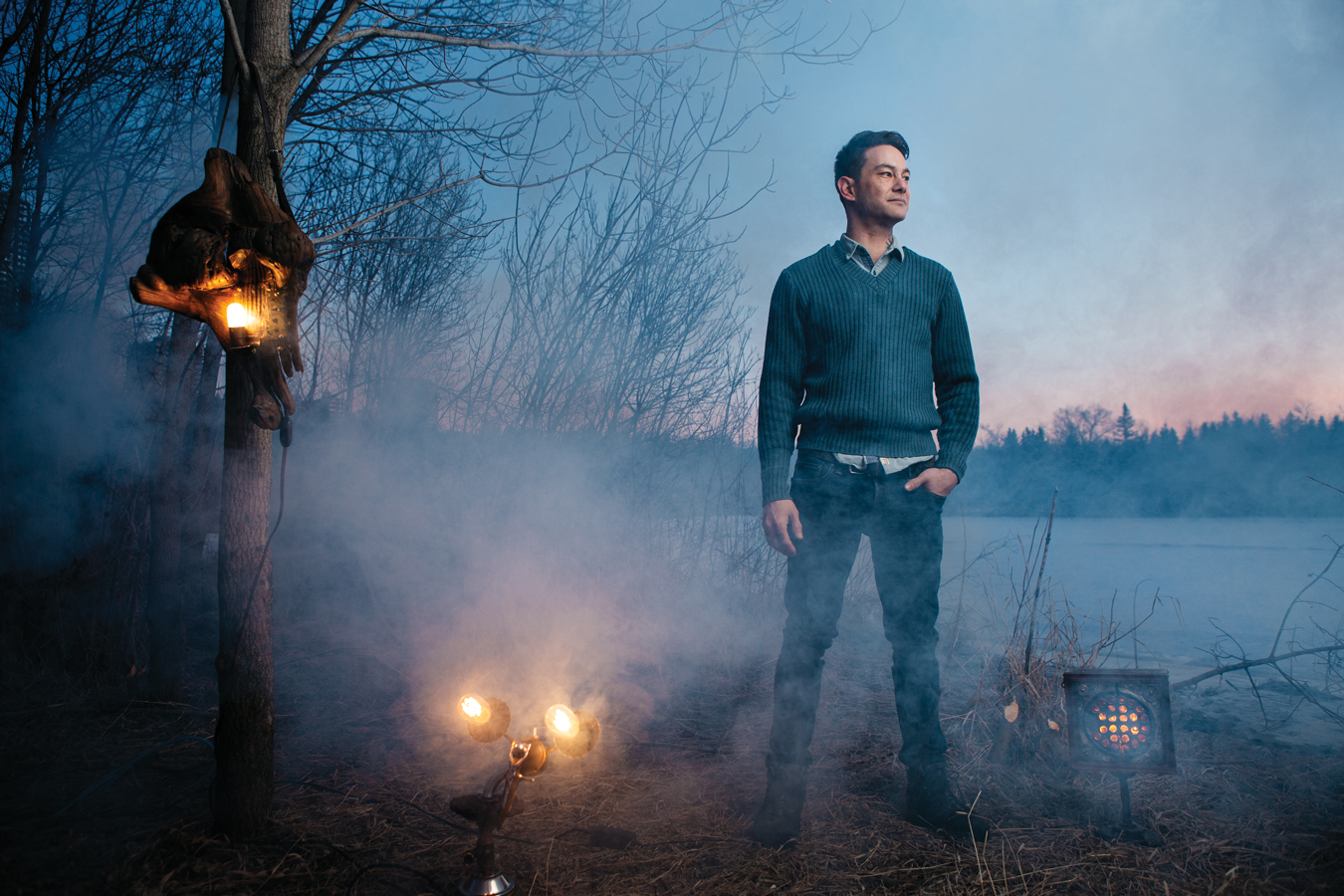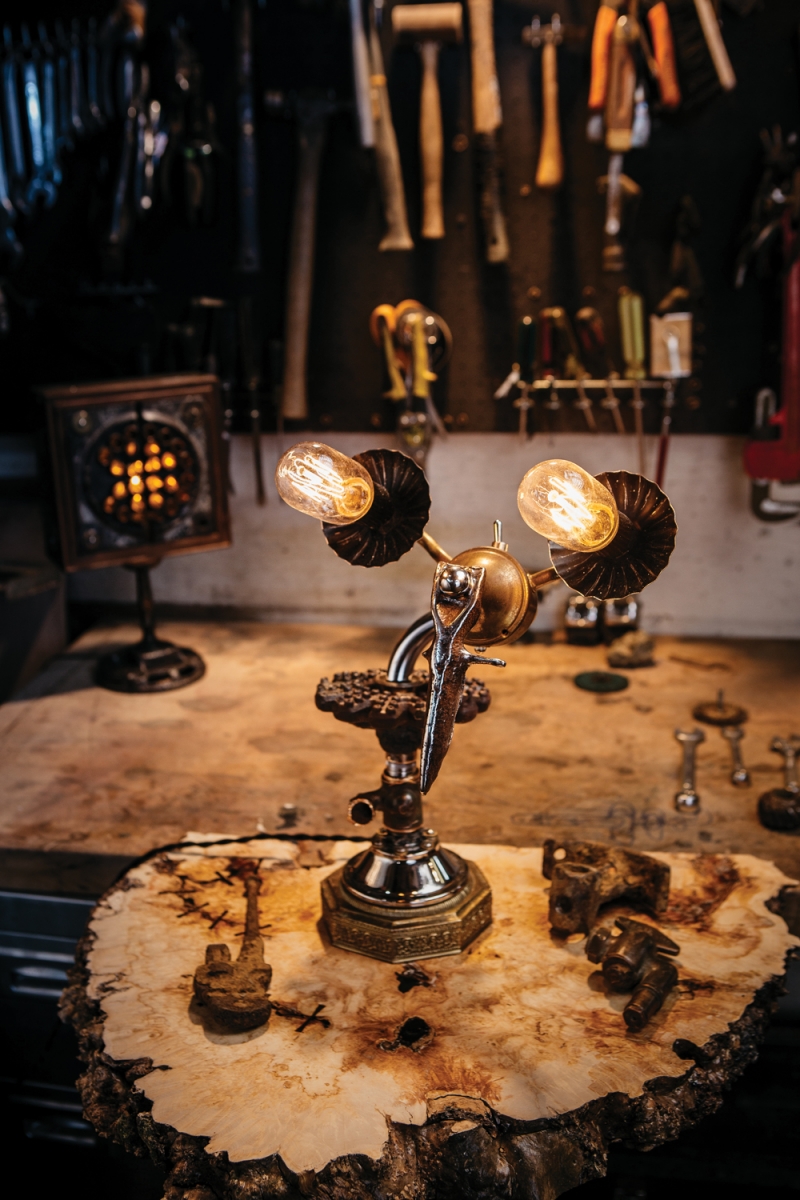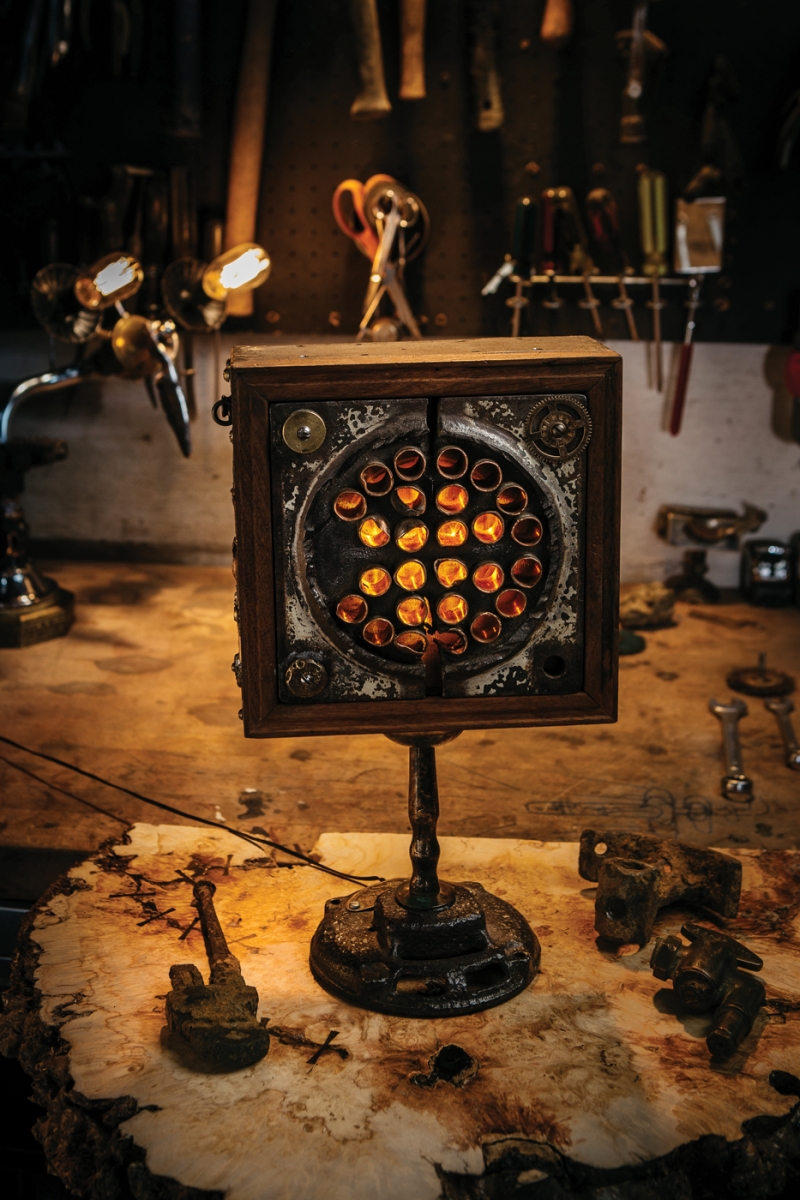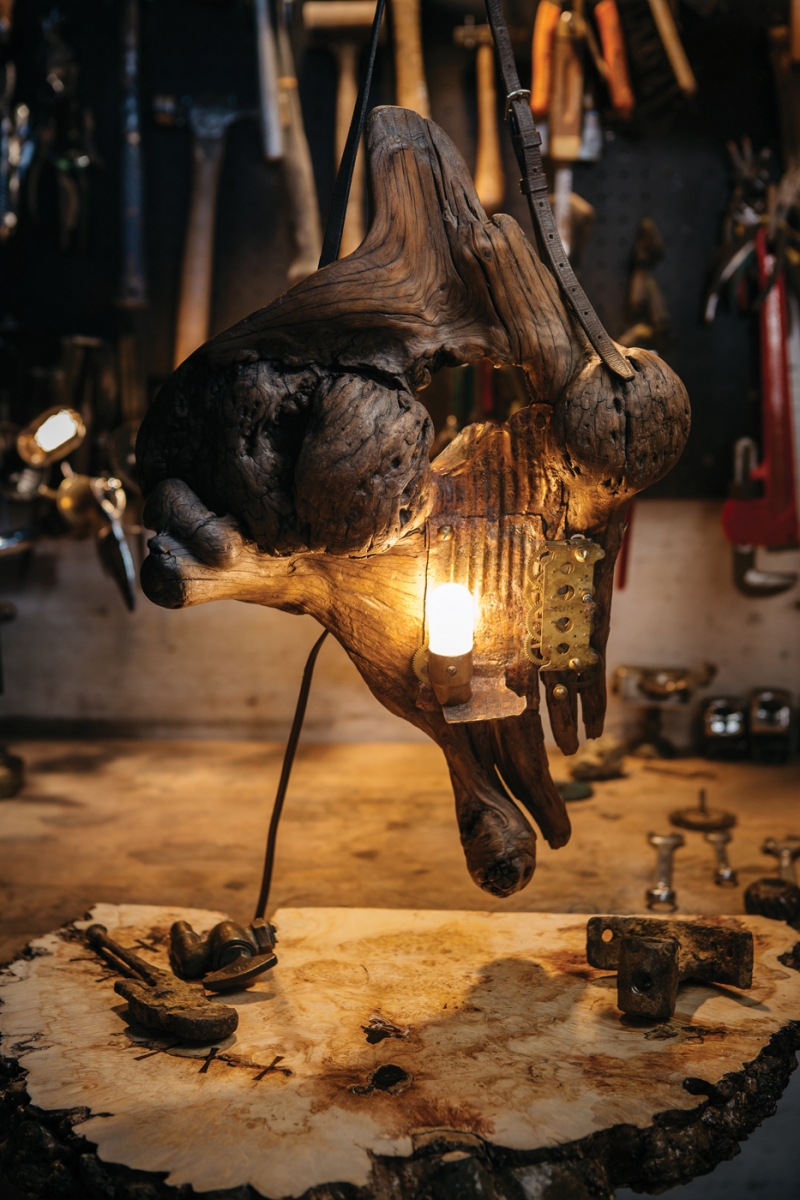On an unusually warm February night in the garage of a north Edmonton bungalow, Chad Baba advises Olivier L’Abbee on the finer points of grenade manufacturing. Truck bearings, some unidentifiable piece of metal serving as a safety lever: To my untrained eye, L’Abbee’s grenade looks like the real deal, straight from the Battle of the Bulge.
Baba and L’Abbee, however, think the design could be improved. The garage is a work studio chock full of industrial cast-offs. At the centre is a large wooden frame that holds chains of rusted-out hardware, the torso of a female mannequin and deer antlers. In a corner is a sculpture made of cutlery that looks like a prop from a Tim Burton movie. Terrifying. Baba’s work table is covered with an old lamp base, wrenches, various bits and a bottle of wine. This is not your grandpa’s workshop.
The next grenade, they decide, will have light radiating from within. Like the sculpture outside the garage – assembled from chains, padlocks and metal cables that turns out to be a peace sign – first impressions are deceptive here. Both L’Abbee and Baba see their art as a form of therapy, a social act to get people from different social classes to start talking to one another.
If this grenade explodes anything, it will be preconceived notions of art as a sanitary, highbrow endeavour.
Baba and L’Abbee make art from Edmonton’s industrial past. They scour decommissioned dump sites and reuse anything they can find. In a way, it’s the ideal medium for folks based in a town with nicknames like “Canada’s Boiler Room” and “Dirt City.” Baba in particular has been embraced by his adopted hometown. He’s exhibited his work at the John Walter Museum and has been featured in documentaries by local filmmakers.
Baba’s arrival in Dirt City, however, was less than auspicious. He “wasn’t keen” on the location, but he wanted to be closer to his daughter. It was a cold and alienating city, especially for a nonconformist from Vancouver with little formal education, but a heart committed to social justice.
Baba found a job working on semi-trucks. One day, while he was reaching up with a drill, his hand got stuck in between the body and the frame of a truck. The drill spun around, but he couldn’t dislodge his hand from the frame in time. “My hand was completely busted up,” Baba said.
He would require multiple surgeries before returning to work. To make matters worse, a doctor noticed that his foot was broken from a BMX accident that had happened years before.
“I was laid up for about three months. I couldn’t walk. I was also beat up on painkillers,” he said. He was also bored. As he slowly regained his footing, he took to the trails of the River Valley with a cane. One day, out of the corner of his eye, he noticed a rusty piece of hardware in a muddy river bank. He dug it out. He gradually worked off the rust and dirt of a gas valve. The strangest part, though, was an inscription of a swastika between the ON and OFF labels.
“It was galvanizing,” Baba says. “It sparked the imagination.”
The discovery sent him on a research mission. It turns out, there is a town in Ontario called Swastika, which manufactured gas valves. Until 1938, on the eve of the Second World War, hardware out of this small Canadian town bore what would become the infamous symbol of Nazism. It was a little-known story that Baba had literally unearthed. He went back to the spot in the River Valley, this time with a backpack. More pieces appeared: Chrome from old cars, toys, even jewellery.
Baba had stumbled upon the site of former dump. “I have whole collections of silver utensils that I pulled up from the river. And to think that they sat on someone’s dinner table for a hundred years. What did they cook? What was the conversation about? What did they do that day? The nuances of used things are so much more interesting than something squeezed out of a mould. You can write your own narrative of objects.”
Ask Baba about where, exactly, his dump is and he demurs. “It’s within city limits along one of the shores of the river. That’s it. I’ve taken a handful of people down there.”
That’s the other thing: it turns out that pulling out artifacts from Edmonton’s former dump site leads you to legal grey area. He had a long back-and-forth with a city councilor about whether his art could be displayed at an exhibit at the John Walter Museum in 2014. “Because I’m a persistent little turd, I managed to get them to write a disclaimer” that allowed him to collect as long as he didn’t actively dig.
The disclaimer also covered the city’s liability for any potential injuries, but, more importantly, it rebranded his hobby. Chad Baba was no longer an out-of-work guy picking through salvage, he was now an environmental artist with a mission to tell Edmonton’s story through its waste.
For most of its history, Edmonton’srelationship to its garbage has been an intimate affair centred on the North Saskatchewan River. Simply put, the river was our dump. Until the 1930s, downtowners simply pushed their refuse off a bluff where passels of hogs and desperate “salvage men” scoured what could be reused. Below the majestic Hotel Macdonald was a notorious landfill – Grierson Dump – that was also a shantytown for migrants during the Great Depression.
Some city officials saw the shantytowns as a public nuisance and lobbied to have them razed. Other people saw the Grierson Dump as a sort of proto-thrift store. An Edmonton Journal reporter met a Dutch immigrant named Smitty in his self-made “bachelor apartment” near the banks of the river in 1937. The reporter found that Smitty made a decent living for himself by turning trash into flower pots and picture frames.
During the Second World War, government propaganda turned salvaging and scrimping into a virtue. Posters reading “Food is a Weapon, Don’t Waste It” adorned public spaces. Doing more with less was part of the war effort. A decade later, our relationship with trash had completely changed again. Now consumption, not salvaging, was considered virtuous and one of the features of Western capitalism that made it superior to communism. Garbage abounded.
Still, even into late 1950s, Edmonton could count on the services of a few last salvage men, descendants of 19th century rag-and-bone pickers, who plied city dumps, recycling (before the word was part of the common vocabulary) garbage for a price. One of the last, a certain G.W. Woodward, wrote the City to complain that rise of disposable post-war culture meant that his way of life was disappearing as former dumps at Grierson Hill and Beverly were shut down and trash was either incinerated or moved beyond city limits.
Baba and L’Abbee are not the only ones recivering Edmonton’s recent past. Haeden Stewart is an archaeologist whose family moved to close to Mill Creek when he was a teenager. He had long noticed something odd about Mill Creek Ravine. Whereas most people saw an idyllic slice of nature running through the city, he saw “traces of a not too distant industrial past that the plants and trees emerged from.”
As a graduate student in archaeology at the University of Chicago, Stewart has done field work in places as varied as the Mexico-Arizona border to Senegal. But for his dissertation, he has decided to look at a place formerly in his backyard. The more he read about Mill Creek Ravine, the more he heard about its former life as an industrial and residential zone.
The only way to really find out about the material life of Mill Creek, he told me, was to dig. As he started excavating on the north end of Mill Creek Ravine, he found all sorts of things, including a very disturbing eyeball that turned out to be a toy. Not only did he find evidence of a once-thriving shantytown, he also discovered that “the dwellings were built, at least partially, out of materials from the surrounding abandoned industrial sites.”
Life in the river valley and ravines of Edmonton wasn’t easy. Stewart say that his excavations, “show the struggle and costs of living so close to an area that is the site of so much pollution and dumping, with residence often dealing with life on the banks of a creek that was flooding at an increasing rate, with higher levels of industrial and city pollution, due to its use as South Edmonton’s outflow.” Shantytown life, though, revealed what Stewart calls Edmonton’s “constant ingenuity.”
That spirit of ingenuity lives on in Baba and L’Abbee’s work.
“The materials we use are a statement,” Baba says. “It’s about what can be done without. Or what can be done with less or instead.”
L’Abbee pauses for a minute. He devises a manifesto on the spot: “Spend less, build more.”
Baba dreams of a day when he can reconcile his interest in social justice with his artistic practice. He cut his teeth as a social worker in Vancouver at the Portland Hotel Society, a not-for-profit that takes a “flexible, creative, and non-judgemental” approach to homelessness and substance abuse. He saw homeless people pore over trailers full of what other people discarded as junk, finding a second life for old televisions, broken bicycles. This aesthetics of survival gave him hope. His ultimate goal is to form a partnership with an organization like the Bissell Centre and “have a bunch of cats make art with me.”
Chad Baba and Olivier L’Abbee are not the only self-taught artists to seek inspiration in garbage, of course. The Ghanaian sculptor El Anatsui – the so-called “King of Trash Art” – has become a darling among the cognoscenti in New York and London by making tapestries out of old beer bottle caps. Other conceptual artists use garbage as a meta-commentary on the transient nature of postmodern culture. The practice of trash art can become paradoxically high-minded.
But unlike the snobs of the New York art world, Baba is clearly having fun. He shows me his Instagram page, with an image of a mannequin of a naked female torso whose appendages are made of kitchen and bathroom hardware. Again, all stuff he found in the dump.
“That’s my Farah Fawcett,” he says. Finally, the joke sinks in. Farah… Faucet. It’s a joke in the tradition of the avant-garde Dadaist Marcel Duchamp, who up shocked the art world in the early 20th century with his readymade objects, like a urinal labelled “Fountain.”
One hundred years after the Dada revolution, it might not be possible to shock anyone with anything. But creating a conversation about art, garbage and social class: That’s something that’s just getting underway in this garage in Dirt City.













